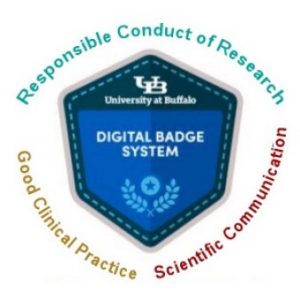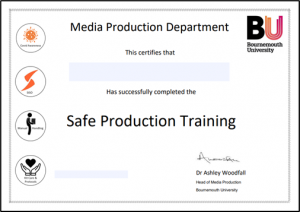Did you know that you can create and award badges in Brightspace? There’s a badge for it, too.
Some research shows that students like them, and that they can improve student engagement and motivation (Roy and Clarke 2019).
Badges can work well in formative assessment, for participation and to some extent for achievement or institutional recognition.
They are also “helping facilitate broader shifts away from measuring, accrediting and credentialing achievement and towards capturing, validating and recognizing learning” (Hickey and Chartrand 2020: 943). And they need to be intrinsically meaningful.
What is gamification?
Gamification is the insertion of game mechanics and thinking in to non-game scenarios. It is now commonplace in everyday life – think of Pokemon, cafe loyalty cards, BU’s ‘Green Rewards’ scheme, or activity recording apps such as Strava or StepsApp.
Badges or Awards such as those available in Brightspace are part of the ‘gamification’ of Higher Education, and part of the shift to learning-focused rather than achievement-focused education.
Telling students that there are badges to be won can encourage them to seek them out, but beware of overuse! If badges are issued indiscriminately they can lose value and the pedagogical purpose is diminished.
You can set release conditions for badges to be awarded automatically on the completion of certain criteria, or award them manually. They can be hidden and be triggered by particular student behaviours. You can use them to award points and generate ‘leaderboards’, although this plays on competition among the student cohort and may be a deterrent for some students.
This is not just for gamers, however!

When might you use digital badges?
You could use awards on your unit to
- Recognise participation and engagement with the unit – ‘Content Explorer’ award for viewing course content
- Motivate and encourage students
- Acknowledge engagement with discussion boards – eg. the first time a student posts to a discussion forum
- Monitor levels of comprehension /achievement? – eg. Quiz Master’ award for those who have completed x number of quizzes passed at or above y %. You could even create badges at bronze, silver and gold level to encourage students to complete reattempts and go for that higher grade
- Document competency with a certification – eg FMC Media Skills Passport

What does the literature say?
There is a growing academic literature on gamification and badges and learning. Recent examples include:
Besser, E. D., Newby, T.J. (2020) Impact of performance feedback for effective use of digital badges. J of Education and Learning, 9.3, 79-91.
- The authors provide a set of optimal feedback suggestions to aid in Mastery Learning and digital badge instruction and consider the implications of these actions in higher education.
Gibson, D., Ostashewski, N., Flintoff, K. et al. (2015) Digital badges in education. Educ Inf Technol 20, 403–410. https://doi.org/10.1007/s10639-013-9291-7
- This paper traces the brief history of digital badges, defines what they are, gives examples of their use, and discusses their educational affordances.
Hickey, D.T., Chartrand, G.T. (2020) Recognizing competencies vs. completion vs. participation: Ideal roles for web-enabled digital badges. Educ Inf Technol 25, 943–956. https://doi.org/10.1007/s10639-019-10000-w
- This article analyses 30 funded efforts to develop badges in educational settings, concluding that participation badge schemes have been more successful than completion badge schemes.
Hickey D.T., Uttamchandani S.L., Chartrand G.T. (2020) Competencies in context: New approaches to capturing, recognizing, and endorsing learning. In: Bishop M.J., Boling E., Elen J., Svihla V. (eds) Handbook of Research in Educational Communications and Technology. Springer, Cham. https://doi.org/10.1007/978-3-030-36119-8_26
- Examples from one digital badge system developed by the authors for an open online course are presented to illustrate new ways of capturing, recognizing, and endorsing learning.
Risquez, A., Cassidy, D., & O’Suilleabhain, G. (2020). Badge of honour? An exploration of the use of digital badges to support a partnership approach to faculty development. Australasian Journal of Educational Technology, 36.5, 18-29. https://doi.org/10.14742/ajet.6112
- This paper argues that “learners benefit most from digital badges when they are linked to and facilitate the development of personal identities associated with disciplinary and professional communities”.
Roy, S., and Clarke, D. (2019). Digital badges, do they live up to the hype? British Journal of Educational Technology 50.5, 2619-36.
- This paper seeks to determine whether digital badges indeed live up to this hype through a systematic review of 23 empirical studies. A series of evaluative research questions have been formulated to guide the analysis of the research literature along with selection criteria to unearth relevant studies. Analysis of this body of work suggests that digital badges can improve student engagement and motivation. There is a concentration of STEM (Science, Technology, Engineering and Mathematics) and humanities & social sciences discipline areas within the studies suggesting that broader research is necessary to determine wider applicability of the results.
Further resources
See also Brightspace Awards Case Study
Guidance on creating and using awards in Brightspace
Online guidance for Brightspace and other TEL Tools is available from the Brightspace Staff Resources area.
Guidance on approaches for assessment is available in the Assessment & Feedback Toolkit.
For further help, contact your Faculty Learning Technologist:







